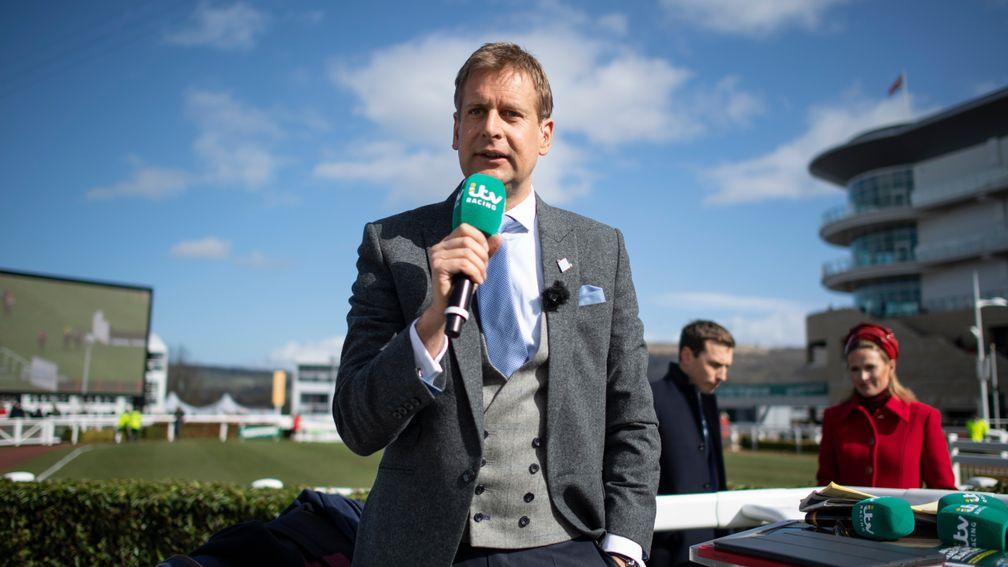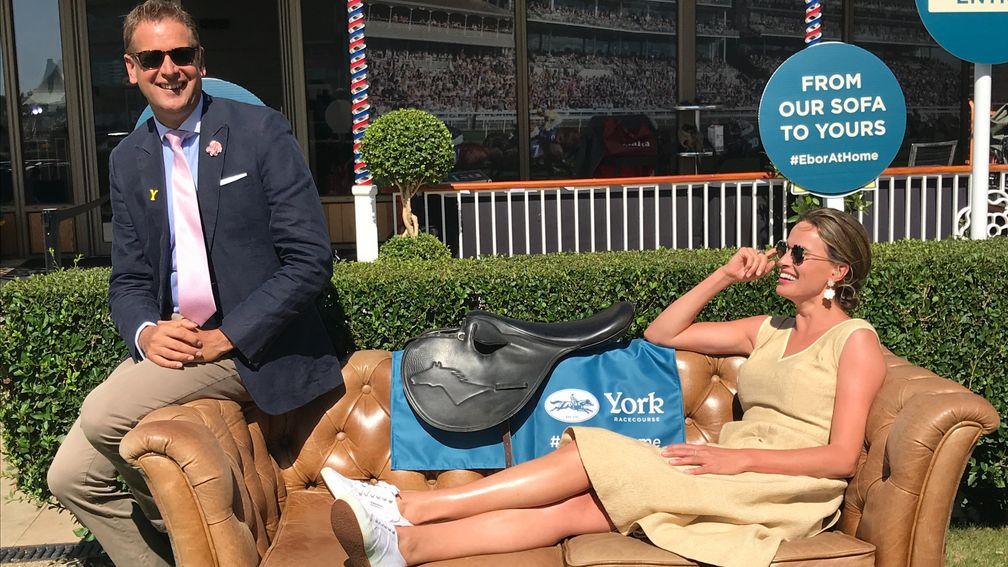ITV is racing's window to the world - so here's how we plan to get even better

Why on earth have you swapped a warm studio with Graeme Souness and Jamie Redknapp for the cold, wind and rain of Cheltenham with Luke Harvey and me?
That was the question posed to me by a bedraggled Sir Anthony McCoy on January 1, 2017.
On New Year's Day four years later I'll be back on the ITV podium at Cheltenham feeling joy – as long as it's not a monsoon – but also relief, after a summer in which I was quoted as saying "racing was sleepwalking into a crisis" with the sport's presence on terrestrial television looking under real threat. The differing goals and constant moving of goalposts meant our tenure looked like being short-lived.
Yet here we are just a few months later and all that uncertainty has turned into a strong bond. ITV is only a custodian of the television rights, but we also see ourselves as racing's partner. The challenges of Covid-19, the sport's PR after the Cheltenham Festival and the need to embrace owners and sponsors have made that partnership closer than ever. The dialogue has never been better. Racing can be bedevilled by factions but, when its family does come together, it can also be an irresistible force. Terrestrial television remains its biggest window to the world.
For all the uncertainty, horror and hardship this pandemic has forced upon racing, the sport has the potential to emerge in a better and stronger position. This year has been brutal for so many and of course racing still has major issues to solve, yet it has been able to show what an important industry it is for the nation's mental and financial health.
More eyes have been on horseracing than for a very long time, with a peak of 1.8 million for Royal Ascot, 2.3 million for the Derby and more than a million viewers for consecutive weekends last month. Now we must take advantage and welcome people to racecourses with open arms. We need to be more inclusive than ever before.
People of my age generally credit an elderly relative or the ITV7 for getting them into racing and I like to think that in 20 years people will say they first enjoyed racing during the lockdown for a global pandemic.
I will stand at Cheltenham on January 1 knowing big challenges on terrestrial television remain. I've presented numerous sports, including athletics, rugby union and football, but nothing has compared to the challenge of fronting horseracing. It's one I had definitely underestimated when I made that switch from Premier League football four years ago.

So what lessons have we learned and how can we improve terrestrial television's coverage of our great sport?
My first piece of advice when media training and discussing the secret to hosting, lecturing and presenting is to know your audience as best you can. Knowing the make-up of who is watching or listening will help you find the right pitch for the talk, presentation or programme, and I am sure this applies to us.
For example, I host very differently on a midweek day on ITV4 than I do on the main ITV channel on a Saturday afternoon. The first is to a more specialist audience compared to the latter, when the bulk of the people watching have probably had a hard week at work and just want to relax and be entertained.
It was similar with football as Super Sunday was more laid-back after Sunday lunch with a big audience, whereas Monday Night Football alongside Gary Neville and Jamie Carragher was a much more hard core and technical broadcast to a smaller, niche audience.
ITV Racing needs to be more like Super Sunday, but that is a much bigger challenge than presenting Premier League football, first because in racing there is so little action and therefore so much more time to fill.
On Super Sunday I'd generally have half an hour before kick-off, three minutes at half-time and a short part at the end. With racing, especially on the Flat, that situation is turned on its head, when the action (the race) can be over in a minute or two and you are left with the challenge of acres of time to keep the viewer engaged. Patience is in short supply these days, which is why you need to move at speed and have 'hooks'. Fortunately, this is something racing has in abundance.
In the 2017 Gimcrack speech I said I hoped to engage the 'players' better than I was able to in football. The response has been brilliant, with our access to the jockeys and their cooperation getting better and better, for which we are extremely grateful. There is still more we can do speaking to the jockeys at the start, bringing the viewer to the heart of the action, and post-race to see where your money and hopes have gone.
Human stories are another great hook. From stable staff to owners and breeders, racing is full of stories. With help from stables, the Racehorse Owners Association and racecourses, we have started to tell those tales and again there is much more we can do.
In the new year we are launching a new regular feature, Reliant On Racing, which is designed to show how many people's livelihoods are dependent on the sport. We must keep drumming home the message what an important industry horseracing is.
But all the time we need to accept the nature of racing's audience on terrestrial television. At a time when viewing figures are being challenged across the board, prior to the pandemic ITV had more than doubled the number of people watching horseracing in our first three years. Lockdown increased that even further. That means a broad church is watching, most of whom want entirely different things.
Alan Tyers had it right in The Telegraph when he asked how do you keep happy "students of the form, people who love the animals for their beauty and fragility, people who like looking at the silks, professional gamblers, the working from home, the pretending to work from home, the sick, the self-isolating, people who have followed racing since the fifties, people who have never watched before, people who left the telly on ITV after This Morning, general sports fans, folk who stick the telly on in the afternoon for a bit of company?".
Knowing the audience and keeping everyone happy will always be a major challenge and the reason we try to have something for everyone on the show. We've often got it wrong and had egg on our face, sometimes of the Scotch variety, but we must always remember we're in the entertainment industry.

Racing fans are only a fraction of the number who watch and play football, rugby or cricket, yet they are incredibly lucky to have two outstanding specialist satellite channels plus more than 90 days a year on terrestrial television. Most sports would give their right arm to have that level of coverage.
Those channels are also broadcasting to different audiences and it's healthy that styles and tone are different. I couldn't begin to do what the Racing TV presenters do and I admire them enormously, but on terrestrial television my lack of a racing background can be a strength as I know when something needs explaining and when to ask a simple question.
One of the difficulties is the game is full of expressions and terms that are normal vocabulary to people who work in it – 'the Pattern', 'handicap', 'on the bridle', etc – but can be incomprehensible to those who don't. So it's important, especially on a main channel day, we explain these in a way that intrigues and enhances people's understanding of our sport. If someone discovers racing on ITV and then progresses to subscribe to Racing TV then our job has been successful.
At the other end of the scale we're always looking to keep the sport's aficionados engaged using technology, graphics and innovative cameras, plus pundits with real authority behind them. Our ethos remains the same: to make racing coverage as accessible and entertaining for as many people as possible.
So we start on the next three-year chapter of a story that began at Cheltenham in 2017 with ITV Racing returning to our screens after a 30-year absence with a programme that was a chaotic, rain-lashed test of resolve. The next day on Andover high street a shopper had not been impressed. "Hi Ed," he yelled, "Ed, you're rubbish."
During Covid, I do think that racing has given hope and offered comfort to people stuck at home. Recent messages on high streets and garage forecourts have been less, "Ed, you're rubbish" and more, "Thank you, watching racing has kept me going".
I think it has us all.
Ed Chamberlin is the lead presenter for ITV Racing and has recently set up a media training and event hosting business www.chamberlinsports.com
Read more:
'Let us entertain you' – Chamberlin delighted as one million tune into Cheltenham
How ITV Racing roared back to life from a Crouch End bedroom (Members' Club subscribers)
Join Members' Club Ultimate and read tipping from the likes of Pricewise and Paul Kealy, all the big interviews and features, daily comment and news analysis – plus our Ultimate Daily newsletter. Click here to sign up.
Published on inComment
Last updated
- We know that times are tight - but racecourses really do need to step up and improve outdated weighing rooms
- The budget has heaped even more trouble on racing - and I fear many trainers will now decide the numbers just don't add up
- Why I think Cheltenham Festival handicaps need to change - JP McManus writes exclusively for the Racing Post
- No-one has ever emerged from the womb wearing a trilby - racing's future survival hangs on pursuing a young audience
- Four score and ten just a number to Peter Harris as July Cup triumph shows there's more to the elderly than medical conditions
- We know that times are tight - but racecourses really do need to step up and improve outdated weighing rooms
- The budget has heaped even more trouble on racing - and I fear many trainers will now decide the numbers just don't add up
- Why I think Cheltenham Festival handicaps need to change - JP McManus writes exclusively for the Racing Post
- No-one has ever emerged from the womb wearing a trilby - racing's future survival hangs on pursuing a young audience
- Four score and ten just a number to Peter Harris as July Cup triumph shows there's more to the elderly than medical conditions